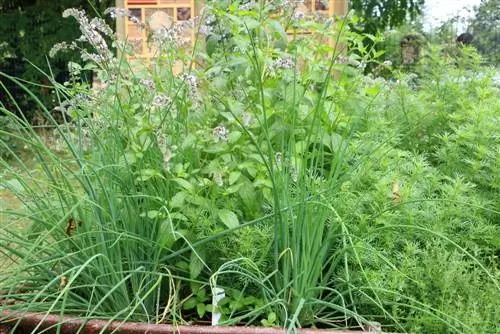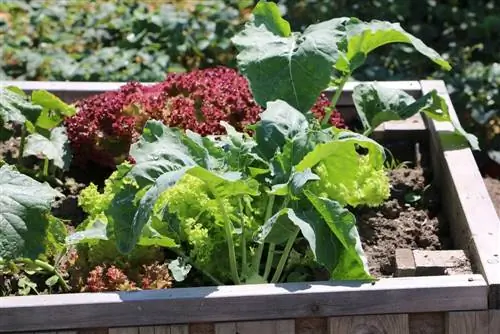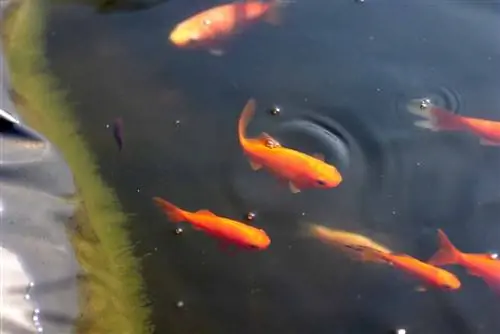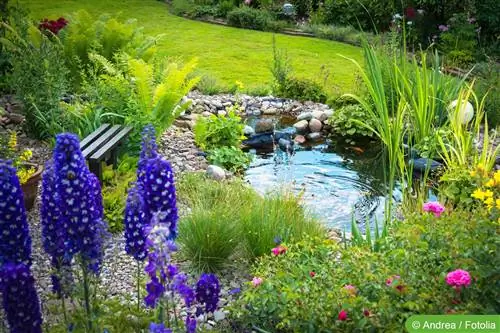- Author admin [email protected].
- Public 2023-12-17 03:39.
- Last modified 2025-01-24 12:45.
Pond borders are an effective method of hiding the edge of the pond and making it decorative. This obscures the pond liner, which does not appear attractive in the garden in any way. In addition, it can become cracked or brittle due to UV rays, which makes pond edge design necessary if you want to enjoy your garden pond for a long time. With the right ones you can do this in a decorative way.
Pond edge design: 10 ideas
The pond shore can be decorated in a variety of different ways. Particular care must be taken to ensure that the edge of the pond fits in with the garden, otherwise the entire pond will appear out of place and will not fit nicely into the concept. If you want to design your own garden pond or finally hide the pond liner, there are a variety of ideas for designing the pond border. The main focus is on a specific material and combining it with plants or other materials in order to create a design that suits your own taste. The following sections will introduce you to 10 ideas that you can use to design your pond edge.
Natural stones
Natural stones are the first choice for many people when it comes to designing the edge of the pond. You can choose from a variety of stones in every size, shape and color imaginable:
- gravel
- gravel
- Fondlings
When using stones, make sure that they do not contain soluble lime. They should also not be sharp on the underside so that the pond liner is not damaged. For example, you can use gravel and gravel to create an open bank area similar to a lake, while you can almost close it off with boulders. You can use natural stones to create small walls that frame only part of the pond. A pond border made of Rhine gravel, which is occasionally filled with boulders and plants, is particularly nice to look at. This way it looks natural and not too overloaded. In combination with a stream it provides that certain something. You can even add small water bowls or planters to the gravel and integrate Asian garden concepts in this way.
Stone slabs
Just as popular as natural stones are stone slabs, which are often placed around the pond and impress with their look. You can implement other ideas depending on the stone slabs used. Natural pond borders can be created with broken stone slabs, which, together with plants, create a rustic or romantic character. This can be expanded with pretty figures. An example would be a small fairy pond with numerous flowers and figures dancing around the water. Stone slabs can also be used as a path to the pond and a simple border. Depending on the type and color of the stone slab, other creative aspects can be implemented.
Plant Bags
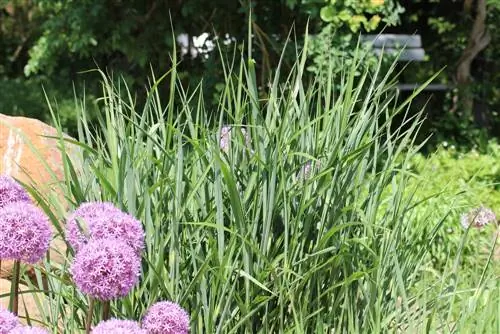
Plant bags are the ultimate classic and are hung into the water over the edge of a pond. In them you can keep plants separated from each other and even at different depths on the bank area. In this way, you can keep numerous aquatic plants without having to create platforms for them in the pond. The biggest advantage of plant bags is their ease of use, as you can add the desired plants to individual sections of the pond edge. Deep ponds that have a steep bank area in particular benefit from using the bags.
Note:
In addition to using plant bags to decorate with plants, you should never forget to plant the bank area. Tall and dense grasses such as miscanthus (bot. Miscanthus sinensis), blue fescue (bot. Festuca cinerea), pampas grass (bot. Cortaderia selloana), silver flag grass (bot. Miscanthus sacchariflorus) or the Japanese sedge (bot. Carex morrowii) are particularly good Suitable for framing your garden pond.
Tiles
Modern or Mediterranean ponds can be created excellently with tiles. Similar to stone slabs, these are laid right up to the water surface. Mosaics that can be created with the tiles are welcome. A popular combination, for example, is the use of tiles for the pond bank and the pond itself if it is filled with koi. Tiles are even suitable for swimming ponds, although for some people it reminds a little too much of a pool.
Wood

If you want to use wood, you can either surround the entire pond with it or just a part of it. This leaves many design options open, especially if you prefer modern elements. Wooden pond borders are ideal for you if you often spend time right next to the water but don't want to have stones or earth under your feet. Garden furniture can be placed on the wood and sunbathing can be enjoyed. Designing one side of the pond with wood and the other with natural stones and plants is particularly decorative. When choosing the wood, make sure that it is resistant to moisture, especially if the pond is used for swimming. If you are interested in wooden pond borders, you can easily expand them with other elements:
- bridges
- Platforms
- Fences
- Roofs
- permanent pavilions
- Planters
Although you have to plan carefully when working with wood, the effort is worth it. If you invest a little more in the wood, you can even create an entire sun deck in large gardens or equip the border with lighting. This makes the edge of the pond look more elegant, of higher quality and invites you to marvel. Wood is very versatile in its application.
Fences
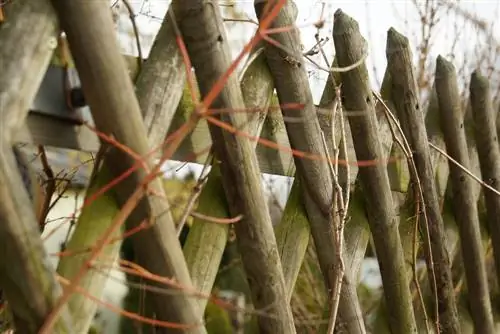
If you use your garden pond primarily as a decoration, you can also use low fences made of metal or wood. With these, the pond looks elegant, decorative and can be easily integrated into the garden art. Together with plants and natural stones, the pond fence becomes a pretty border, which also effectively prevents small children and pets from falling into the pond. There are numerous pond fences on the market, but you can also build your own.
Tip:
A decorative alternative to a fence is a low wall that will give your garden a completely different charm. Particularly noteworthy are the color variations of the walls, which can be attractively integrated into your garden and are particularly suitable for ponds with ornamental fish that should have little contact with people or pets.
Beach
Creating a beach is popular in large gardens with a swimming pond. This is usually demarcated by stones, a low fence or path slabs and is ideal for sunbathing in the summer. You can create a beach in different ways:
- Sand
- gravel
- Stone slabs
- Grass and gravel
The most important thing when creating a beach for the garden pond is to use enough pond liner. Equally important is a foundation, for example made of gravel, which functions as drainage and is covered with garden fleece. This prevents sand or gravel from sinking downwards. Children are particularly enthusiastic about a beach pond.
Waterfall
How about a waterfall as the edge of the pond? If you have planned a stream for your garden pond, you can let it flow into a waterfall you created yourself. Large garden ponds in particular can be made into something unique with such a design concept. Such a waterfall is particularly appealing if you create it from natural stones. What is important with this idea is the height of the waterfall. Don't make it too high if you don't have enough space for it or if you only have a small stream, otherwise the waterfall will become more of a trickle. If you have limited space in the garden, a waterfall with steps is recommended.
Metal
If you want an industrial, rustic or futuristic style, you can go for metal. For example, you have the option of setting a simple edge made of aluminum or a metal in a rust design that clearly separates the pond from the lawn or terrace. This variant looks clean and is particularly recommended for gardens in which not so many plants are used or where they do not want to extend too much into the pond. You can also use water basins made of Corten steel. Although this doesn't really correspond to a traditional pond, you can keep aquatic plants and pond inhabitants in it. In addition, you kill two birds with one stone, as the tubs usually do not have pond borders. The look is particularly suitable for gardens that are modern or minimalist.
Concrete
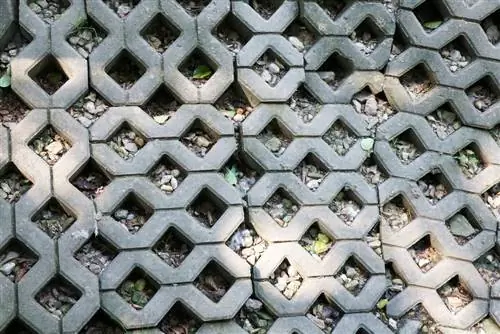
Concrete has the advantage that all possible design concepts can be implemented. Do you want a waterfall? Then make it out of concrete. Maybe you would prefer a gargoyle that contains the pump? The possibilities are limitless and with a little imagination, you will come up with even more variations that will fit nicely into your garden. Setting concrete steps or a straight surface leading to the pond is also popular. You can also use creative designs from fairy tales, films or other sources to design the edge of the pond with concrete. A pond bank can be embellished with concrete temple elements from Asia. Even concrete bricks can be used.
Tips for pond edge design
In addition to the ideas for pond edging mentioned above, there are also a few points to consider. All too quickly, a garden pond appears out of place or too cluttered due to incorrect design. In most cases, this is because pond owners use unsuitable elements for the pond size or the entire garden design does not suit it. You don't want to put a pond in a natural garden whose bank has modern, minimalist elements. Likewise, the pond bank should not only attract attention, but rather direct it to the still water. The following tips will help you implement the above ideas better:
Too steep bank
Be careful not to make the bank too steep. Not only does the film become visible when the water level is occasionally lower, animals and people can even drown in extreme cases if the bank area is too steep. Especially when slippery algae encourage slipping. In addition, a bank that is too steep makes it difficult to implement the ideas mentioned above. Use a gentle slope or multiple bank areas at different heights to avoid this problem. This also makes it easier to design the pond border.
Riverside areas
Select only a part of the pond edge that can be entered. Either a footbridge is built on this, a small platform or path slabs lead to it. If you use the beach variant, you should move the beach at this point. The other areas can be used for plants and as resting places for pond inhabitants. Of course, this is not necessary or desired for particularly modern versions, as it does not always fit visually.
Order
Always make the pond borders first before filling the water into the pond. In this way, you can check beforehand whether all aspects of the pond edge meet your expectations and are secured so that you don't have to pump all the water out of the pond again before making any changes.


